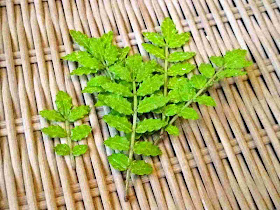Leaves of sansho Zanthoxylum piperitum
For cooking, the green leaves of late spring or early summer are a common garnish for a number of dishes. They are also chopped and added to marinade or sauce, or ground to make dressing.
The leaves have a subtle spiciness that makes your tongue tingle while the aroma of fresh citrus fills your nostrils.
Young sansho leaves are called kinome, which literally means tree buds.
My sansho shrub starts to leaf out in June – it is the last shrub in my garden to take action. Every year, I look forward to its short season of green leaves to taste with fish.
Aside from leaves, sansho fruit is used as an ingredient in tsukudani, a strong-flavored little dish often used as a rice topping, and dried fruit skins are made into powder, which is also an ingredient of shichimi pepper spice.
Hua jiao, Sichuan peppercorns, is the dried fruit (and skins) of a relative shrub, Zanthoxylum bungeanum.
Recipes with kinome
- Saba no oshizushi / pressed sushi with grilled mackerel
- Fuki to ebi no ohitashi / Japanese butterbur and shrimp marinated in light broth
- Petoraaru karei no kinome-miso-yaki / grilled petrale sole with kinome sansho miso
- Petoraaru karei no shioyaki, kinomezu-gake / grilled petrale sole with young sansho leaf dressing
- Jagaimo to satsumaimo no sansho gomaae / potato and sweet potato in sansho sesame dressing
- Takenoko no kinomeae / bamboo shoot in sasho leaf miso dressing
- Unagi no yanagawa-fu donburi / grilled eel with burdock root and egg on rice, with sansho leaves
- Tara no kinome-yaki / grilled cod in sansho pepper leaf marinade
Try kinome in the following recipes
- Nasu no dengaku / eggplant with sweet miso sauce (as garnish)
- Takenoko gohan / steamed rice with bamboo shoots (as garnish)
- Wakatakejiru, tara iri / clear soup with wakame seaweed and bamboo shoot, with grilled cod (as garnish)
- Chirashizushi / sushi with assorted ingredients and julienned egg crepe (as garnish)
(Last updated: June 11, 2016)

No comments:
Post a Comment